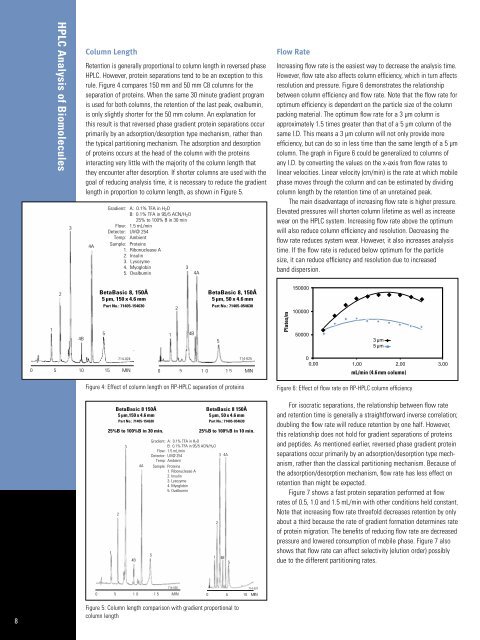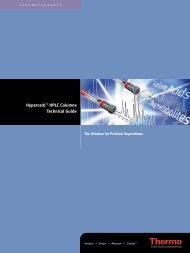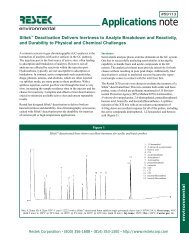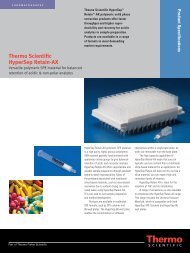HPLC Analysis of Biomolecules Technical Guide - Interscience
HPLC Analysis of Biomolecules Technical Guide - Interscience
HPLC Analysis of Biomolecules Technical Guide - Interscience
Create successful ePaper yourself
Turn your PDF publications into a flip-book with our unique Google optimized e-Paper software.
8<br />
<strong>HPLC</strong> <strong>Analysis</strong> <strong>of</strong> <strong>Biomolecules</strong><br />
Column Length<br />
Retention is generally proportional to column length in reversed phase<br />
<strong>HPLC</strong>. However, protein separations tend to be an exception to this<br />
rule. Figure 4 compares 150 mm and 50 mm C8 columns for the<br />
separation <strong>of</strong> proteins. When the same 30 minute gradient program<br />
is used for both columns, the retention <strong>of</strong> the last peak, ovalbumin,<br />
is only slightly shorter for the 50 mm column. An explanation for<br />
this result is that reversed phase gradient protein separations occur<br />
primarily by an adsorption/desorption type mechanism, rather than<br />
the typical partitioning mechanism. The adsorption and desorption<br />
<strong>of</strong> proteins occurs at the head <strong>of</strong> the column with the proteins<br />
interacting very little with the majority <strong>of</strong> the column length that<br />
they encounter after desorption. If shorter columns are used with the<br />
goal <strong>of</strong> reducing analysis time, it is necessary to reduce the gradient<br />
length in proportion to column length, as shown in Figure 5.<br />
Figure 4: Effect <strong>of</strong> column length on RP-<strong>HPLC</strong> separation <strong>of</strong> proteins<br />
Figure 5: Column length comparison with gradient proportional to<br />
column length<br />
Flow Rate<br />
Increasing flow rate is the easiest way to decrease the analysis time.<br />
However, flow rate also affects column efficiency, which in turn affects<br />
resolution and pressure. Figure 6 demonstrates the relationship<br />
between column efficiency and flow rate. Note that the flow rate for<br />
optimum efficiency is dependent on the particle size <strong>of</strong> the column<br />
packing material. The optimum flow rate for a 3 µm column is<br />
approximately 1.5 times greater than that <strong>of</strong> a 5 µm column <strong>of</strong> the<br />
same I.D. This means a 3 µm column will not only provide more<br />
efficiency, but can do so in less time than the same length <strong>of</strong> a 5 µm<br />
column. The graph in Figure 6 could be generalized to columns <strong>of</strong><br />
any I.D. by converting the values on the x-axis from flow rates to<br />
linear velocities. Linear velocity (cm/min) is the rate at which mobile<br />
phase moves through the column and can be estimated by dividing<br />
column length by the retention time <strong>of</strong> an unretained peak.<br />
The main disadvantage <strong>of</strong> increasing flow rate is higher pressure.<br />
Elevated pressures will shorten column lifetime as well as increase<br />
wear on the <strong>HPLC</strong> system. Increasing flow rate above the optimum<br />
will also reduce column efficiency and resolution. Decreasing the<br />
flow rate reduces system wear. However, it also increases analysis<br />
time. If the flow rate is reduced below optimum for the particle<br />
size, it can reduce efficiency and resolution due to increased<br />
band dispersion.<br />
Figure 6: Effect <strong>of</strong> flow rate on RP-<strong>HPLC</strong> column efficiency<br />
For isocratic separations, the relationship between flow rate<br />
and retention time is generally a straightforward inverse correlation;<br />
doubling the flow rate will reduce retention by one half. However,<br />
this relationship does not hold for gradient separations <strong>of</strong> proteins<br />
and peptides. As mentioned earlier, reversed phase gradient protein<br />
separations occur primarily by an adsorption/desorption type mechanism,<br />
rather than the classical partitioning mechanism. Because <strong>of</strong><br />
the adsorption/desorption mechanism, flow rate has less effect on<br />
retention than might be expected.<br />
Figure 7 shows a fast protein separation performed at flow<br />
rates <strong>of</strong> 0.5, 1.0 and 1.5 mL/min with other conditions held constant.<br />
Note that increasing flow rate threefold decreases retention by only<br />
about a third because the rate <strong>of</strong> gradient formation determines rate<br />
<strong>of</strong> protein migration. The benefits <strong>of</strong> reducing flow rate are decreased<br />
pressure and lowered consumption <strong>of</strong> mobile phase. Figure 7 also<br />
shows that flow rate can affect selectivity (elution order) possibly<br />
due to the different partitioning rates.





